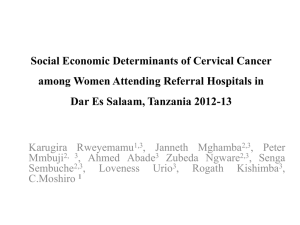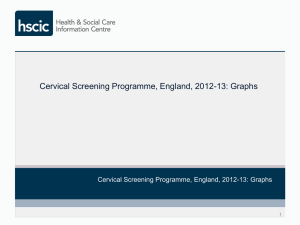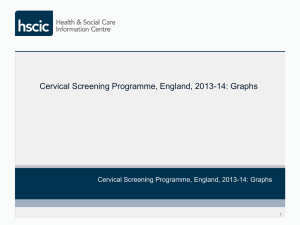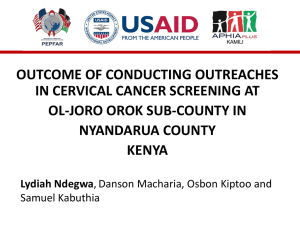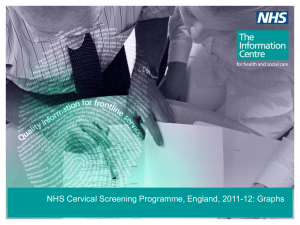National Cervical Cancer Prevention and Control Program, Dr
advertisement
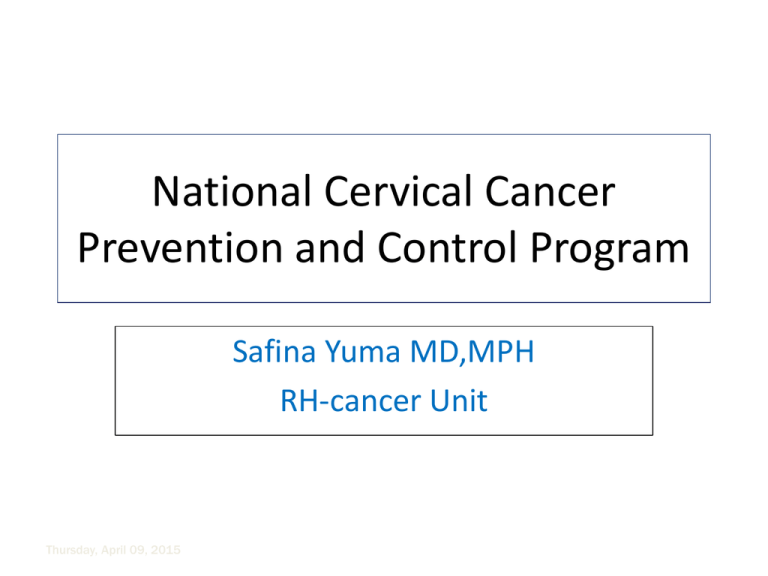
National Cervical Cancer Prevention and Control Program Safina Yuma MD,MPH RH-cancer Unit Thursday, April 09, 2015 1 Presentation Outline • Background & burden of disease • Overview of the National CECAP and Control Program • Program progress o Primary Prevention o Secondary Prevention (screening, treatment, referrals) • Challenges • Lessons learned 2 Background • Cervical cancer is the most common cancer in Tanzania – Leading cause of cancer related morbidity and mortality in women in the country • Tanzania has one of highest cervical cancer burdens in the world and the highest in Eastern Africa – Age-standardized incidence rate (ASR) of 50.9 cases per 100,000 women • Despite the high burden, majority of women in Tanzania do not have access to CECAP services Cervical Cancer Burden Country/Re gion Thursday, April 09, 2015 Incidenc e Rate (per 100,000) Mortality Rate (per 100,000) Tanzania 50.9 37.5 Eastern Africa 34.5 25.3 Africa 25.2 17.6 4 NEW CANCER CASES AT OCEAN ROAD CANCER INSTITUTE 2006 - 2011 Type of Cancer 2006 2007 2008 2009 2010 2011 Cervical cancer 955 1006 1288 1374 1510 1881 Kaposi sarcoma 295 404 418 447 681 814 Breast cancer 244 245 275 322 386 526 Esophageal cancer 181 256 282 307 380 511 Head and neck 155 206 244 272 289 361 Lymphomas 201 199 226 245 186 269 Leukemias 46 78 87 103 142 261 Urinary bladder 46 88 87 98 109 153 Skin cancer 40 108 111 123 129 141 Eye cancers 46 76 80 95 84 119 Others 598 472 382 390 299 208 TOTAL 4/9/2015 2807 3138 3480 3776 4195 5224 5 Cervical Cancer Prevention and Control Program in Tanzania The government of Tanzania is committed to address cervical cancer burden 2008 : MoHSW established a RH-Cancer unit through its Reproductive and Child Health Section (RCHS). The Tanzania Cervical Cancer Technical Working Group provides guidance to the national program. To increase demand for CECAP services MoHSW collaboration with partners developed; The National Cervical Cancer Prevention and Control Strategic Plan (2011-2015) Developed Tanzania CECAP and Control service delivery guidelines IEC materials-Posters and Brochures Monitoring Tools Training package-final stage National TOT –for VIA/Cryo National TOT- for LEEP 6 Strategic Framework • Vision: women free from the burden of cervical cancer in Tanzania • Mission: The MOHSW is committed to translate cancer prevention and control knowledge into public health action in collaboration with stakeholders including community. • The Goal of Strategic Plan : To reduce Cervical Cancer Incidence, morbidity and Mortality in Tanzania Program progress • HPV vaccine launched in Tanzania as demonstration project may 2014 • Launch of the community awareness Campaigns for cervical and breast cancer strong support by the First Lady, mama Kikwete (WAMA Foundation) • Cervical cancer indicators included into the DHIS Monitoring Thursday, April 09, 2015 8 Secondary Prevention • MoHSW endorsed low cost tech VIA screening test as a national strategy to promote access • feasible to implement at low levels of the health care system. • Main focus: SVA –screening and treatment using • Cryotherapy (all facilities-with skilled personnel) • LEEP (Regional & District level facilities) • Target group: 30-50 years & HIV positive at any age • Screening frequency: 3 years (HIV-/Unk) and yearly for HIV+ women • Integration: RCH services • /HIV care services/gyn clinic • Coverage: more than 200 screening sites SECONDARY PREVENTION CURRENT STATUS OF PARNER REGIONAL SUPPORT EGPAF/MST EGPAF/ WHO ENGEND IMA World ICAP MST • ICAP/ 12D EGPAF THPS EGPAF CER12 UMATI THPS DOD DOD Upcoming: 1.PSI-Private Hospitals 2.Mtwara: EGPAF/THPS 3.UMATI sites JHPI EGO/ PSI WHO DSM: MDH/ JHPIEGO JHPIEGO EGPAF Focus: 1. Regional level Hospitals 2. District level Hospitals 3. Few Health Centers Referral Pathway Large lesions: Regional Hospitals, District Hospitals with skilled providers Suspicious for Cancer: CCS site-Regional Hospital, or referral to MNH or to ORCI Confirmed Cervical Cancer: referred to ORCI for radiotherapy treatment and palliative care (upcoming Bugando MC) 11 Challenges • Shortage of staffs & work overload -providers doing CECAP as one amongst other services Linkages of CCS • Lack of pathology services at regional level facility • Referral system for suspect cancer cases and large lesions • Maintenance of cryotherapy units • Re-screening of one year follow up clients is still very low • Essential equipment still not included within MSD catalogue eg. Cryo and LEEP machines • Long term sustainability of the program Thursday, April 09, 2015 12 Lessons Learned • • • • • • • Acceptability of the program is very high Referral system for SC/LL needs improvements Mechanism for maintenance of Cryo & LEEP machines need to be strengthened Not easy to include CCS budget line item in CCHP (competing priorities) National level advocacy of CECAP program is highly needed Updating CECAP training curriculum in pre service education for nursing & medical schools must be the future direction to ensure sustainability of CECAPC program With strong partnership and collaboration we can easily scale up CCS services in the country Thursday, April 09, 2015 13 Breast cancer • Mass Screening Campaigns for breast cancer • No standardized guidelines • Solicit funds for the program Thursday, April 09, 2015 14
